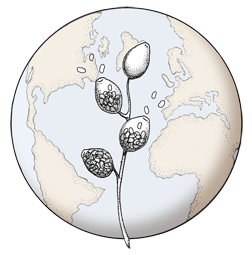References
Export 183 results:
Author Title [ Type ] Year
] Year Filters: First Letter Of Last Name is G [Clear All Filters]
Phytophthora agathidicida: research progress, cultural perspectives and knowledge gaps in the control and management of kauri dieback in New Zealand. Plant Pathology [Internet]. 2020 ;69(1):3 - 16. Available from: https://bsppjournals.onlinelibrary.wiley.com/doi/full/10.1111/ppa.13104
. Phytophthora acerina sp. nov., a new species causing bleeding cankers and dieback of Acer pseudoplatanus trees in planted forests in northern Italy. Plant Pathology [Internet]. 2013 ;63(4):858–876. Available from: http://dx.doi.org/10.1111/ppa.12153
. Phosphonate controls sudden oak death pathogen for up to 2 years. California Agriculture [Internet]. 2009 ;63:10-17. Available from: http://ucanr.org/repository/cao/landingpage.cfm?article=ca.v063n01p10&fulltext=yes#
. Phenotypic diversification Is associated with host-induced transposon derepression in the sudden oak death pathogen Phytophthora ramorum. PLoS ONE [Internet]. 2012 ;7:e34728. Available from: http://dx.doi.org/10.1371%2Fjournal.pone.0034728
. Phenotypic differences among three clonal lineages of Phytophthora ramorum. Forest Pathology [Internet]. 2011 ;41:7–14. Available from: http://dx.doi.org/10.1111/j.1439-0329.2009.00627.x
. PCR-RFLP markers identify three lineages of the North American and European populations of Phytophthora ramorum. Forest Pathology [Internet]. 2009 ;39:266–278. Available from: http://dx.doi.org/10.1111/j.1439-0329.2008.00586.x
. Pathogenicity of Phytophthora pluvialis to Pinus radiata and its relation with red needle cast disease in New Zealand. New Zealand Journal of Forestry Science [Internet]. 2014 ;44(1):6. Available from: http://www.nzjforestryscience.com/content/44/1/6
. Pathogenicity of Phytophthora austrocedrae on Austrocedrus chilensis and its relation with mal del ciprés in Patagonia. Plant Pathology [Internet]. 2010 ;59:604–612. Available from: http://dx.doi.org/10.1111/j.1365-3059.2010.02258.x
. Pathogenicity and infectivity of Phytophthora ramorum vary depending on host species, infected plant part, inoculum potential, pathogen genotype, and temperature. Plant Pathology [Internet]. 2021 ;70(2):287 - 304. Available from: https://bsppjournals.onlinelibrary.wiley.com/doi/10.1111/ppa.13297
. On-Site DNA Extraction and Real-Time PCR for Detection of Phytophthora ramorum in the FieldABSTRACT. Applied and Environmental Microbiology [Internet]. 2005 ;71(11):6702 - 6710. Available from: https://pubmed.ncbi.nlm.nih.gov/16269700/
. O complexo gomose da acácia-negra. Colombo-PR: Embrapa Florestas [Internet]. 2001 ;Circular Técnica, 44:8 pp. Available from: https://core.ac.uk/download/pdf/15427678.pdf
. Non-oak native plants are main hosts for sudden oak death pathogen in California. Cal Ag [Internet]. 2003 ;57:18-23. Available from: http://ucanr.org/repository/cao/landingpage.cfm?article=ca.v057n01p18&abstract=yes
. A new threat to UK heathland from Phytophthora kernoviae on Vaccinium myrtillus in the wild. Plant Pathology [Internet]. 2009 ;58:393–393. Available from: http://dx.doi.org/10.1111/j.1365-3059.2008.01961.x
. A multi-locus phylogeny for Phytophthora utilizing markers derived from complete genome sequences. Fungal Genetics and Biology [Internet]. 2008 ;45:266 - 277. Available from: http://www.sciencedirect.com/science/article/B6WFV-4PYP77J-1/2/ebf8754b49bc2fd36ab9e34941eeed43
. Morphological and genetic analyses of the invasive forest pathogen Phytophthora austrocedri reveal that two clonal lineages colonized Britain and Argentina from a common ancestral population. Phytopathology [Internet]. 2017 ;107(12):1532 - 1540. Available from: https://apsjournals.apsnet.org/doi/10.1094/PHYTO-03-17-0126-Rhttps://apsjournals.apsnet.org/doi/pdf/10.1094/PHYTO-03-17-0126-R
Mitotic Recombination and Rapid Genome Evolution in the Invasive Forest Pathogen Phytophthora ramorum . mBio [Internet]. 2019 ;10(2). Available from: https://mbio.asm.org/content/10/2/e02452-18
. Microsatellite markers identify three lineages of Phytophthora ramorum in US nurseries, yet single lineages in US forest and European nursery populations. Molecular Ecology [Internet]. 2006 ;15:1493–1505. Available from: http://dx.doi.org/10.1111/j.1365-294X.2006.02864.x
. A microsatellite analysis identifies global pathways of movement of Phytophthora cinnamomi and the likely sources of wildland infestations in California and Mexico. Phytopathology [Internet]. 2019 . Available from: https://apsjournals.apsnet.org/doi/10.1094/PHYTO-03-19-0102-R
. Managing Port-Orford-Cedar and the Introduced Pathogen Phytophthora lateralis. Plant Disease [Internet]. 2000 ;84:4-14. Available from: http://apsjournals.apsnet.org/doi/abs/10.1094/PDIS.2000.84.1.4
. Management of red needle cast, caused by Phytophthora pluvialis, a new disease of radiata pine in New Zealand. New Zealand Plant Protection [Internet]. 2014 ;67:48–53. Available from: http://www.nzpps.org/nzpp_abstract.php?paper=670480
. Lineage, Temperature, and Host Species have Interacting Effects on Lesion Development in Phytophthora ramorum. Plant Disease [Internet]. 2014 ;98(12):1717 - 1727. Available from: http://apsjournals.apsnet.org/doi/abs/10.1094/PDIS-02-14-0151-RE
. Lineage, Temperature, and Host Species have Interacting Effects on Lesion Development in Phytophthora ramorum. Plant Disease [Internet]. 2014 ;98(12):1717 - 1727. Available from: http://apsjournals.apsnet.org/doi/abs/10.1094/PDIS-02-14-0151-RE
. Limited morphological, physiological and genetic diversity of Phytophthora palmivora from cocoa in Papua New Guinea. Plant Pathology [Internet]. 2017 ;66:124–130. Available from: http://doi.wiley.com/10.1111/ppa.12557
. Le Phytophthora heveae du cocotier: son rôle dans la pourriture du cøeur et dans la chute des noix. Oléagineux [Internet]. 1984 ;39:477–485. Available from: http://cat.inist.fr/?aModele=afficheN&cpsidt=8960536
. Involvement of Phytophthora species in the decline of European beech in Europe and the USA. Mycologist [Internet]. 2005 ;19:159 - 166. Available from: http://www.sciencedirect.com/science/article/B7XMS-4R10WR2-5/2/37dcb413ca17af3b17f99e6101570c65


